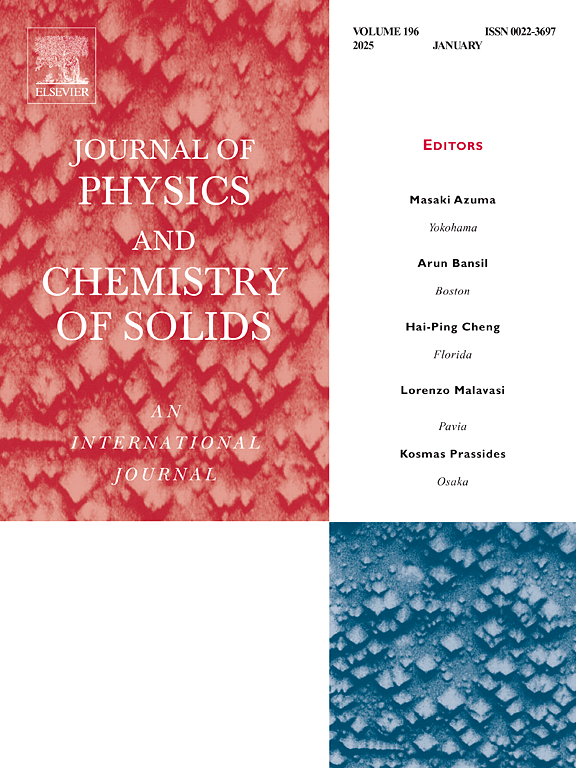通过控制制备方法,设计高性能LiNi0·8Co0·1Mn0·10o2阴极
IF 4.9
3区 材料科学
Q2 CHEMISTRY, MULTIDISCIPLINARY
引用次数: 0
摘要
对高能锂离子电池的需求刺激了对富镍层状正极材料的广泛研究,特别是LiNi0·8Co0·1Mn0·1O2 (NMC811)。然而,诸如阳离子混合和结构不稳定等挑战仍然存在,阻碍了它们的广泛应用。研究了共沉淀和高能球磨工艺对NMC811锂离子电池正极材料理化和电化学性能的协同效应。通过精心控制共沉淀过程中的氨浓度,实现了前驱体材料内均匀的颗粒分布。随后的高能球磨进一步细化了材料,促进了颗粒尺寸的减小和氧空位浓度的增加,正如不同的表征所证实的那样。这些结构修饰提高了电化学性能,包括提高了速率能力和循环稳定性。电化学阻抗谱证实了这些增强,表明与未经球磨合成的NMC811相比,球磨样品的锂离子扩散系数显著提高,界面电阻降低。在0.5C下循环100次后,球磨NMC811的容量保留率为81%,而非球磨样品的容量保留率为69%。这种改进归功于减小的颗粒尺寸和增加的氧空位,这促进了锂离子更快的扩散,直接由增加的DLi支持,以及增强的结构稳定性,部分是通过减轻循环过程中有害的相转变,如H2-H3转变。研究结果强调了将共沉淀与高能球磨相结合的潜力,作为开发高性能NMC811阴极的可行策略,用于先进的锂离子电池应用。本文章由计算机程序翻译,如有差异,请以英文原文为准。
Engineering high performance LiNi0·8Co0·1Mn0·1O2 cathodes through controlling fabrication methods
The demand for high-energy Li-ion batteries has spurred extensive research on Ni-rich layered cathode materials, particularly LiNi0·8Co0·1Mn0·1O2 (NMC811). However, challenges such as cation mixing and structural instability persist, hindering their widespread application. This study investigates the synergistic effects of co-precipitation and high-energy ball milling techniques on the physicochemical and electrochemical properties of NMC811 cathode materials for lithium-ion batteries. By meticulously controlling ammonia concentration during co-precipitation, a uniform particle distribution within the precursor material was achieved. Subsequent high-energy ball milling further refined the material, promoting a reduction in particle size and an increase in oxygen vacancy concentrations, as confirmed by different characterizations. These structural modifications resulted in enhanced electrochemical performance, including improved rate capability and cycling stability. Electrochemical Impedance Spectroscopy confirmed these enhancements, revealing a significantly higher Li-ion diffusion coefficient and reduced interfacial resistances for the ball-milled sample, compared to NMC811 synthesized without ball milling. The ball-milled NMC811 exhibited a higher capacity retention of 81 % after 100 cycles at 0.5C, compared to 69 % for the non-ball-milled sample. This improvement is attributed to the reduced particle size and increased oxygen vacancies, which facilitate faster lithium-ion diffusion, as directly supported by the increased DLi, and enhanced structural stability, partly by mitigating detrimental phase transitions like the H2–H3 transition during cycling. The findings underscore the potential of combining co-precipitation with high-energy ball milling as a viable strategy for developing high-performance NMC811 cathodes for advanced lithium-ion battery applications.
求助全文
通过发布文献求助,成功后即可免费获取论文全文。
去求助
来源期刊
CiteScore
7.80
自引率
2.50%
发文量
605
审稿时长
40 days
期刊介绍:
The Journal of Physics and Chemistry of Solids is a well-established international medium for publication of archival research in condensed matter and materials sciences. Areas of interest broadly include experimental and theoretical research on electronic, magnetic, spectroscopic and structural properties as well as the statistical mechanics and thermodynamics of materials. The focus is on gaining physical and chemical insight into the properties and potential applications of condensed matter systems.
Within the broad scope of the journal, beyond regular contributions, the editors have identified submissions in the following areas of physics and chemistry of solids to be of special current interest to the journal:
Low-dimensional systems
Exotic states of quantum electron matter including topological phases
Energy conversion and storage
Interfaces, nanoparticles and catalysts.

 求助内容:
求助内容: 应助结果提醒方式:
应助结果提醒方式:


